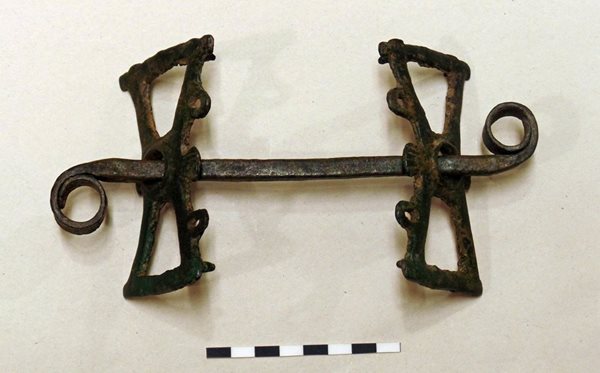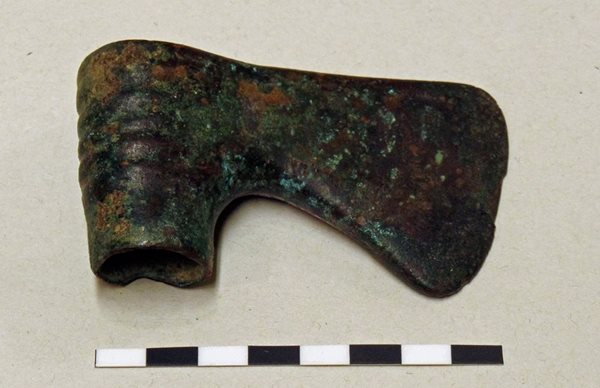Circa 9th century BC
Luristan Bronzes
Circa 9th century BC, found in modern day Iran
Sometime in the 1920s, large amounts of bronze objects were discovered by local peasants in a remote part of modern day Iran called Luristan in what turned out to be ancient cemeteries.
by Leo McNamee
Discovery and Acquisition by the National Museum
The bronzes were admired in European museums for their fine craftsmanship and exotic decoration which led to an increased demand for them in the west; unfortunately this resulted in the systematic looting of these ancient cemeteries. The lack of any proper archaeological excavation resulted in very little information being recorded. Today, bronze artefacts from this part of the Near East can be found in museums all over Europe and America emphasising just how widely these objects were distributed.

These three objects were acquired by the National Museum of Ireland in 1939 at auction in London. They formed part of a collection belonging to T.A. Glenn Esq. and were acquired along with a large number of bronze objects from Ireland. Listed in the auction catalogue under “foreign bronze implements”, these objects were described as:
“A bronze horse-bit with openwork cheek pieces, a plain dagger blade and a perforated bronze axe, the socketed end decorated with ribs in relief.”Upon learning that this collection was to be auctioned in London, the museum made a request to the seller to withdraw the objects and instead sell them directly to the museum. The museum hoped this would secure a better price but the request came too late in the day and the objects could not be withdrawn. Nonetheless, the museum managed to secure all the Irish and some of the foreign objects in the collection. The Director of the Museum at that time, Dr. Adolf Mahr, wrote to the Department of Education to report this:
“I beg to report that we have done very well at the auction in London and that the whole group of something like fifty bronzes etc. has been secured for the National Museum…I consider the total price of £140 extremely reasonable and very well worth our endeavours to obtain.”
Decorative Horse-bit, Socketed Axehead and Tanged Dagger
The horse-bit is typical of many found in Luristan with openwork cheek-pieces that each have two loops for the cheek-straps of the headstall and a central hole through which passes the mouth-piece. Both ends of the mouth piece terminate in a loop for the reins to pass through and each cheek-piece has spikes on the inner surface for added control. This example is relatively plain but many have more elaborate openwork. Horse-bits like these were often placed under the head of the deceased when found in properly excavated graves. The other two items are a socketed axehead and tanged dagger; weapons like these are the most common type of artefact type from Luristan. The majority of properly excavated male graves contained weapons and it has been suggested that the form of these objects meant that they had no practical use and were made specifically for deposit as grave goods.

Ancient Luristan
The province is named after its inhabitants, the various Lur tribes. It is a region of open plains that is surrounded by high mountain ranges and rivers which would have made it a natural fortress in antiquity. The area is important in an archaeological context as it is here, along with neighbouring Kurdistan, that the earliest evidence for the domestication of sheep and goats appears; dated to the early Post-Pleistocene period (around 9000-7000 BC). Recent excavations have established that bronze objects such as these were produced in the area over a long period from circa 2500 – 700 BC.

It is not known who was responsible for creating these objects but it has been suggested that a migration of nomads into the region brought this technology with them; however there is little evidence for the origins of these nomads who could have been Kassites, Iranians or Cimmerians. Furthermore, there is increased evidence for Mesopotamian influence at the end of the second millennium BC with the names of various Babylonian kings inscribed in cuneiform on a number of weapons. This was a period of political upheaval with King Nebuchadnezzar coming to power in Babylon (1124-1103 BC). The Luristan metal industry thrived until sometime around the seventh century BC when the increasing power of the Persians and Medes cut off access to the copper and tin mines that were needed to provide the raw materials for bronze working.
Learn More…
These objects are part of the museum’s reserve collection and are not currently on display. However, other items from the Documentation Discoveries series are currently on display in the National Museum of Ireland – Archaeology.
References
Moorey, P.R.S. (1974), Ancient Bronzes from Luristan, British Museum Publications
Mortensen, I.D. (1993), Nomads of Luristan, Thames Hudson
Location:
Luristan Bronzes is located at:
In Storage
Previous artefact:
Next artefact:
